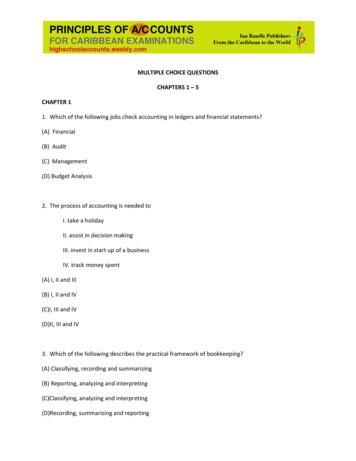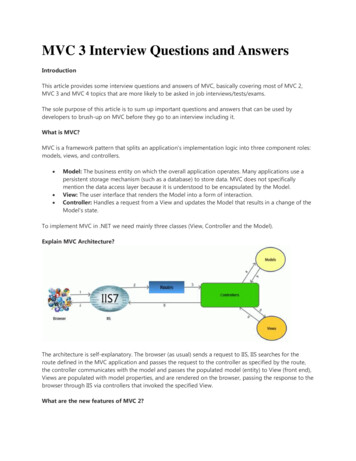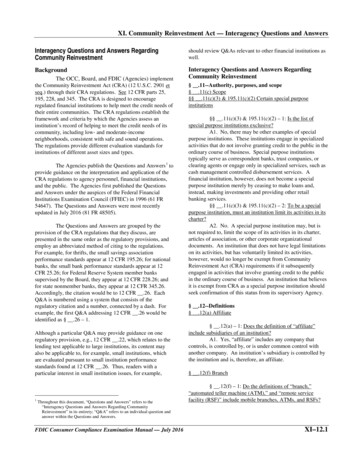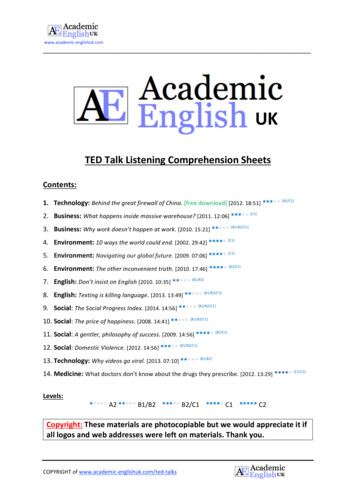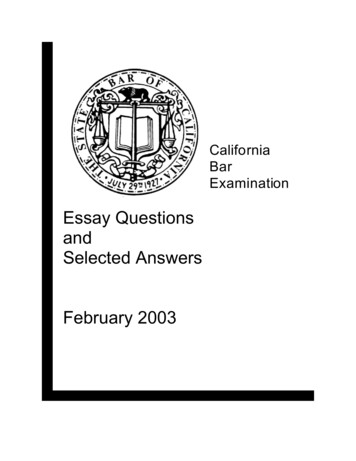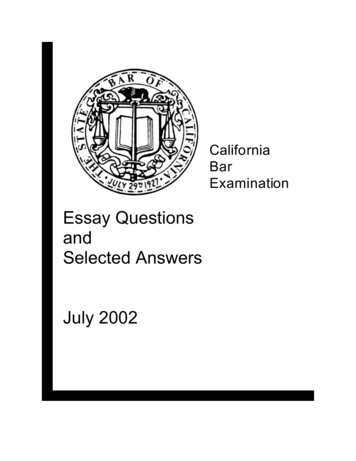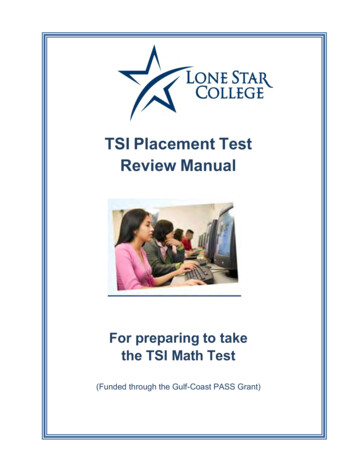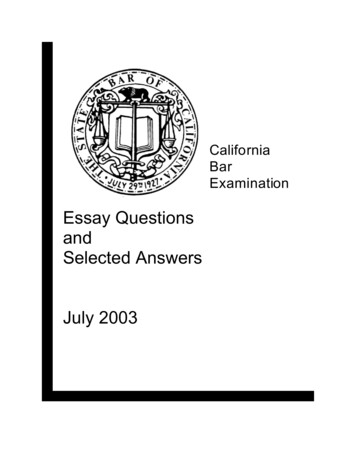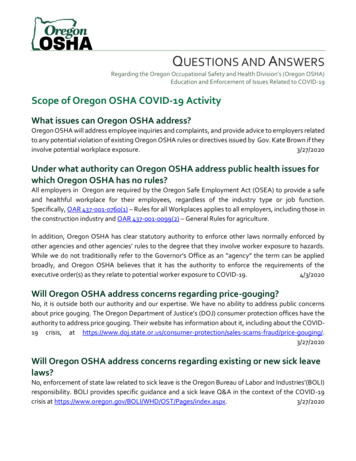
Transcription
QUESTIONS AND ANSWERSRegarding the Oregon Occupational Safety and Health Division’s (Oregon OSHA)Education and Enforcement of Issues Related to COVID-19Scope of Oregon OSHA COVID-19 ActivityWhat issues can Oregon OSHA address?Oregon OSHA will address employee inquiries and complaints, and provide advice to employers relatedto any potential violation of existing Oregon OSHA rules or directives issued by Gov. Kate Brown if theyinvolve potential workplace exposure.3/27/2020Under what authority can Oregon OSHA address public health issues forwhich Oregon OSHA has no rules?All employers in Oregon are required by the Oregon Safe Employment Act (OSEA) to provide a safeand healthful workplace for their employees, regardless of the industry type or job function.Specifically, OAR 437-001-0760(1) – Rules for all Workplaces applies to all employers, including those inthe construction industry and OAR 437-001-0099(2) – General Rules for agriculture.In addition, Oregon OSHA has clear statutory authority to enforce other laws normally enforced byother agencies and other agencies’ rules to the degree that they involve worker exposure to hazards.While we do not traditionally refer to the Governor’s Office as an “agency” the term can be appliedbroadly, and Oregon OSHA believes that it has the authority to enforce the requirements of theexecutive order(s) as they relate to potential worker exposure to COVID-19.4/3/2020Will Oregon OSHA address concerns regarding price-gouging?No, it is outside both our authority and our expertise. We have no ability to address public concernsabout price gouging. The Oregon Department of Justice’s (DOJ) consumer protection offices have theauthority to address price gouging. Their website has information about it, including about the COVID19 crisis, at les-scams-fraud/price-gouging/.3/27/2020Will Oregon OSHA address concerns regarding existing or new sick leavelaws?No, enforcement of state law related to sick leave is the Oregon Bureau of Labor and Industries’(BOLI)responsibility. BOLI provides specific guidance and a sick leave Q&A in the context of the COVID-19crisis at px.3/27/2020
If Oregon OSHA is enforcing the Governor’s Executive Order, will we betaking complaints about individuals who do not stay in their home?No. Our authority and involvement is limited to businesses and to the workplace. In fact, no stateagencies will be questioning whether drivers have a valid reason to remain at home. The attacheddocument from the Oregon State Police may be helpful if people have questions on this issue. Althoughthe order is summarized in the phrase “Stay at Home; Stay Safe” the real point of the order is to avoidor at least minimize in-person contact outside the home. A driver alone in his or her car raises noconcerns on that score for any law enforcement or regulatory body.3/27/2020OSP Enforcement FAQWill Oregon OSHA be addressing concerns about crowds on beaches or inparks or congregating in other locations?No. Our authority and involvement is limited to businesses and to the workplace. If individuals haveconcerns about groups congregating they need to address those to local authorities using nonemergency contact numbers. Because such activities are very visible it is also likely that local lawenforcement will become aware of them relatively quickly even without receiving a complaint or othernotification. How they address them, of course, will be a question for local authorities, taking intoaccount their available resources and other factors.3/27/2020Expectations of Businesses and other EmployersAre all non-essential businesses required to cease operations?No. Although some businesses are required to close to the public, no businesses are required to entirelycease operations, so businesses may still expect employees to come to work.3/27/2020Which businesses must close their doors to the public?Because the governor has determined that close personal contact in Paragraph 2 of Executive OrderNo. 20-12 (issued March 23, 2020) mandates the closure of the following:Amusement parksAquariumsArcadesArt galleries (to the extent they are open without appointment)Barber shops and hair salonsBowling alleysCosmetic storesDance studiosEsthetician practicesosha.oregon.gov2
Fraternal organization facilitiesFurniture storesGyms and fitness studios (including climbing gyms)Hookah barsIndoor and outdoor malls (specifically, all portions of a retail complex containing stores andrestaurants in a single area)NOTE: This prohibition does not apply to mall operations that provide food, grocery, health care,medical, pharmacy or pet store servicesIndoor party places (including jumping gyms and laser tag)Jewelry shops and boutiques (unless they provide goods exclusively through pick-up or deliveryservice)Medical spas, facial spas, day spas, and non-medical massage therapy servicesMuseumsNail and tanning salonsNon-tribal card roomsSkating rinksSenior activity centersSki resortsSocial and private clubsTattoo/piercing parlorsTennis clubsTheatersYoga studiosYouth clubs3/27/2020Can such businesses continue to have employees work during themandated closure?Yes. Employees can perform work (cleaning, maintenance, inventory, etc.) inside the business while itis closed.3/27/2020Can we use PPE to allow employees to work in close contact?Social Distancing and PPEOregon OSHA expects workplaces to comply with the governor’s Executive Order No. 20-12 to maintainsocial distancing and meet Oregon occupational safety and health workplace standards. The CDC hasprovided guidance on wearing cloth face coverings in public to help slow COVID-19 transmission.Employers are expected to maintain required social distancing in their workplaces following a processsimilar to the hierarchy of controls. First, employers should eliminate, substitute, or postpone noncritical tasks involving employee close contact. Then, use engineering controls, administrative controls,and safe work practices to maintain social distancing at the workplace. The use of face coverings orrespirators alone can not be the singular solution for achieving the important effects of socialosha.oregon.gov3
distancing. Keeping in line with the hierarchy of controls, PPE and cloth face coverings should beutilized as a last resort.If these modifications are unable to achieve the social distancing requirements and employees mustwork in close contact in order to complete business-critical tasks, then PPE (such as successfully fittedrespirators) should be used to supplement, but not replace, production and work practice modifications.Most importantly, it is critical to emphasize that maintaining 6-feet social distancing remains importantto slowing the spread of the virus. Employers must recognize that the use of PPE to circumvent socialdistancing requirements is a last resort option after all other feasible controls and safeguards have beenimplemented. PPE alone cannot be used by employers to comply with social distancing requirements.Please keep in mind, there is a severe shortage of PPE in Oregon. It is imperative that healthcarefacilities have an adequate supply of PPE to protect our healthcare providers on the front line of thisemergency. Governor Brown issued Executive Order No. 20-10 to conserve PPE. EO No. 20-10, stronglyencourages all industries (except healthcare) to cancel or postpone non-essential uses of PPE duringthe ongoing state of emergency, so that equipment can be conserved and redirected to the State’sCOVID-19 response via the Office of Emergency Management. All of those wishing to donate surplusPPE, should contact the PPE Coordinator listed in EO No. 20-10 at (971)-900-9952.4/14/2020What are Oregon OSHA’s comments about cloth face coverings?The CDC recommends wearing cloth face coverings in public settings where other social distancingmeasures are difficult to maintain (e.g., grocery stores and pharmacies). This recommendation isparticularly important in areas of significant community-based transmission.As stated by the Oregon Health Authority, preventing transmission of the COVID-19 virus depends onphysical distancing, frequently washing hands and surfaces, and staying home when you are sick.Personal Protective Equipment (PPE) (e.g. masks, gowns and gloves) protects healthcare personnelwho are taking care of patients with COVID-19. A shortage of PPE has prompted many in the public tooffer to make face coverings for healthcare personnel. In addition, the Centers for Disease Control andPrevention (CDC) released recommendations April 3, 2020, regarding cloth face coverings for thegeneral public.Here are Oregon Health Authority’s recommendations:Oregon Guidance on Use of Homemade Masks or Face Coverings by the Public to Prevent Spread ofCOVID-19: April 4, 2020Strictly speaking, a cloth face covering is not personal protective equipment (PPE) in the traditionalsense of how PPE is used, nor does it meet the design specifications for respiratory protection. The useosha.oregon.gov4
of cloth face coverings are encouraged from a public health perspective because they ensure the maskwearer covers their cough or sneeze by default.It is critical to emphasize that maintaining 6-feet social distancing remains important to slowing thespread of the virus. CDC is additionally advising the use of simple cloth face coverings to slow the spreadof the virus and help people who may have the virus and do not know it from transmitting it to others.Cloth face coverings fashioned from household items or made at home from common materials at lowcost can be used as an additional, voluntary public health measure.This CDC webpage includes instructions for making a cloth face cover.4/14/2020What about restaurants and bars?The operation of restaurants and bars was addressed by Executive Order No. 20-07 (issued March 17,2020), which banned on-site consumption of food and drink at food establishments. Such organizationscan continue to provide delivery and pickup (both curbside and interior) services.3/27/2020What about other retail businesses not listed in the answer above?Paragraph 6 of Executive Order No. 20-12 prohibits all other retail businesses from operating unless thebusiness designates an employee or officer to establish, implement, and enforce social distancingpolices, consistent with guidance from the Oregon Health Authority (OHA). While many suchbusinesses are operating in manners similar to those required of restaurants and bars, the ExecutiveOrder does not strictly require it. However, it certainly should be encouraged.3/27/2020What about grocery, health care, medical or pharmacy services?Paragraph 8 of the executive order exempts such businesses from the requirements of Paragraph 6,although they are encouraged to comply with social distancing guidelines (most such businesses appearto have implemented procedures to minimize [although not to eliminate] contact between staff andcustomers even at the point of purchase).3/27/2020What about child care facilities?Licensed childcare facilities must close from March 25, 2020, through April 28, 2020, unless that periodis extended or terminated earlier by the governor. Not withstanding this order, childcare facilities areallowed to remain open during this effective period if they meet requirements that address “stable”group size and prioritize the childcare needs of first responders, emergency workers, healthcareprofessionals, followed by critical operations staff and essential personnel, consistent with guidanceprovided by the Oregon Department of Education, Early Learning Division.The governor has delegated authority to the Oregon Department of Education, Early Learning Division,to set forth exceptions to the rule allowing childcare facilities to remain open during the effectiveperiod, if it becomes necessary to do so. Oregon OSHA does not expect to address complaints aboutosha.oregon.gov5
child care facilities, and certainly has no authority to address the questions about prioritizing services.3/27/2020What about work in office environments?Beginning March 25, 2020, Section 9 of Executive Order No. 20-12 prohibits businesses and non-profitsfrom work in offices whenever telework or work-at-home options are available in light of positionduties, availability of teleworking equipment, and network adequacy.3/27/2020What about government offices?Paragraphs 12 and 13 apply to the executive branch of state government. It requires all such offices toclose to the public to the maximum extent possible and to provide services by phone and online duringregular business hours. When contact with the public must take place, social distancing measures mustbe enforced to the maximum extent possible. It also requires teleworking to the maximum extentpossible and requires a social distancing designee to the degree such telework options are not possible.Paragraph 12 and 13 of the executive order do not apply to the state legislative or judicial branches,federal government, local government, or tribal governments, although they are encouraged to adhereto the same policies.3/27/2020Will Oregon OSHA take complaints related to the teleworkingrequirements?Yes, if the employee is alleging worker exposure as a result of the failure to provide teleworking. Butthe evaluation of whether a business or non-profit is in violation will be a fact-specific and complexdetermination. If the employer has appointed an individual to establish, implement and enforce socialdistancing policies (as required by Section 10) and has made a reasonable effort to determine whethertelework options are available, it is unlikely that we would be able to cite a violation of this provision.3/27/2020In several places the Executive Order refers to closing businesses for noncompliance. Will Oregon OSHA order such closures?Oregon OSHA will close a business only in the event of a flagrant refusal to comply. Such an order shouldnot be issued without approval from the Administrator (Michael Wood), the Deputy Administrator (JulieLove), or the Oregon OSHA Policy Manager (Renee Stapleton). If we do so, we will be relying on the redwarning notice authority found in the Oregon Safe Employment Act.3/27/2020osha.oregon.gov6
Do construction, agriculture, or non-retail establishments need toappoint someone to identify social distancing measures and enforcethem?Strictly speaking, no. But they should do so. For example, the Oregon Home Builders Association hasrecommended to all its members that they should follow the guidance in the governor’s ExecutiveOrder as it relates to social distancing and its enforcement.4/3/2020Without a specific requirement, is there anything Oregon OSHA can doto address worker concerns in businesses not covered by the order?Yes. We still have jurisdiction to address complaints alleging workers are at risk. And, while proving allthe elements of a general duty violation (should it come to that) would be more difficult, we certainlywould have no problem proving that COVID-19 is a recognized hazard. We may not be able to tell anemployer in such a situation exactly what they must do, but we can reasonably advise them that thesituation does require them to take specific measures to minimize the risk their employees face.3/27/2020What resources are available to help businesses and other employers?There are several avenues to obtain information, including industry-specific guidance put out by anumber of organizations.Oregon OSHA has information available for employers at https://osha.oregon.gov/Pages/re/covid19.aspxIn addition, both the CDC and federal OSHA have resources for businesses and employers:CDC: y/organizations/businessesemployers.htmlFederal OSHA: https://www.osha.gov/Publications/OSHA3990.pdfAt least one workers’ compensation insurance carrier has dedicated financial assistance in relation toCOVID-19. Check with your insurance carrier to see if they are offering assistance.3/31/2020Use of touchless thermometers (therm. guns) as part of an employer’sscreening protocolCDCBest practices for taking temperature - /COVID-19 CAREKit ENG.pdfosha.oregon.gov7
Oregon Health Authority’s position on taking temperature:Oregon Guidance for Employers on COVID-19In circumstances where on-site temperature measurement is being implemented, temporal scanners(touch forehead), and no-touch methods might be used in order to reduce contact between screenersand potentially ill individuals. However, compared to oral or rectal measurement, no-touchthermometers have low sensitivity for temperatures greater than 38C. This means some people withfever will go undetected by temporal or no-touch methods.Anyone who performs temperature screening should use appropriate personal protective equipmentas described elsewhere tion.html). Non-disposable thermometers should beappropriately sanitized between use and the person performing screening should adhere to infectioncontrol practices.U.S. Equal Employment Opportunity CommissionSource: https://www.eeoc.gov/eeoc/newsroom/wysk/wysk ada rehabilitaion act coronavirus.cfmA.3. When may an ADA-covered employer take the body temperature of employees during theCOVID-19 pandemic? (3/17/20)Generally, measuring an employee's body temperature is a medical examination. Because the CDCand state/local health authorities have acknowledged community spread of COVID-19 and issuedattendant precautions, employers may measure employees' body temperature. However, employersshould be aware that some people with COVID-19 do not have a fever.4/17/2020When should employers NOT permit the use of cloth face coverings orvoluntary respiratory protection (e.g. N95, dust masks) in the workplace?There are two general circumstances where employers should not permit the use of cloth face coveringsor voluntary respiratory protection in the workplace:1) There is a medical concern that using such equipment could create a greater health risk to theemployee user(e.g. asphyxiation, loss of consciousness, suffocation, lung failure).2) The use of such respiratory equipment creates a severe hazard in it of itself (i.e. greater hazardsthat may be immediately injurious to life or health).Mitigation of the spread of COVID-19 in the workplace is important; however, such hazard controlefforts must not supersede task-specific hazard control methods required by an existing Oregon OSHArule (e.g. asbestos) or create additional severe hazards for employees. An employer who is faced withprotecting employees from COVID-19 transmission or protecting against a hazard that is immediatelyosha.oregon.gov8
injurious to life or health, should protect employees from the greater hazard first. However, thisdetermination must be made by an employer on a case by case basis for a particular workplace.Examples of greater hazards may include, but is not limited to: ElectrocutionFire, burns, explosions, flame engulfmentIDLH atmospheres (defined as, immediately dangerous to life or health means an atmosphericconcentration of any toxic, corrosive, or asphyxiant substance that poses an immediate threatto life or would cause irreversible or delayed adverse health effects or would interfere with anindividual’s ability to escape from a dangerous atmosphere)Amputation, evulsions, or loss of bone, cartilage, or eyesEmployers must implement feasible controls to curb the spread of COVID-19 in their workplace.Additionally, employers should delay, postpone, or minimize to the extent possible, those workoperations that require employees to work within six feet of one another. As detail in previous OregonOSHA COVID-19 guidance, PPE alone should not be used by employers to control against COVID-19transmission in the workplace.Oregon OSHA recommends that employers evaluate and document conditions in their workplace thatmay require employees to deviate from OHA or CDC guidance for COVID-19 that is related to PPE. If agreater hazard is created by the use of inadequate or non-compatible PPE or homemade equipment(e.g. cloth face masks, aprons, gowns) these items should not be used during that particular work task.In the absence of a greater hazard, employers should continue to promote the use of voluntaryrespiratory protection or cloth face coverings in accordance with current OHA or CDC guidelines.Finally, employers should inform employees who are impacted by any changes to their workplace PPEpolicies and hazard control measures in response to COVID-19.4/30/2020Where can our medical facility request more PPE? We are not getting anymedical-grade masks, gowns, or face shields.Upon restarting non-emergent and elective procedures that require personalprotective equipment (PPE) in medical and dental offices, where can clinics obtainPPE?As Oregon restarts activities that have been temporarily halted, it is important be mindful of the balancebetween commerce and the health of Oregonians. Oregon’s economy and it’s public health functiontogether to sustain each system.osha.oregon.gov9
As a public agency, Oregon OSHA does not recommend any provider of personal protective equipment(PPE). Oregon OSHA does not stockpile PPE, nor does the agency have access to separate PPE supplychains that are not already commercially available to the public. In addition to local retail and wholesalesafety supply companies, employers may wish to inquire directly with manufacturers.Medical or dental clinics that are in need of PPE for non-emergent and elective procedures, but couldnot find PPE from commercial vendors, should call their local public health authority according tocounty. The clinic needs to identify who they are and what they are seeking, and the county can advisethem on the next steps.Directory for county public health authoritiesWhat evidence is there of an adequate supply of PPE for healthcare workers that willbe performing non-emergent and elective medical and dental procedures thatrequire PPE?The Governor’s Office stated on April 23, 2020 that Oregon’s collection and conserving of PPE has beensuccessful. In addition, a machine for cleaning and disinfecting masks is scheduled to be received soon.Furthermore, masks and gowns have been produced by local organizations and companies; manyorganizations and companies have donated PPE, and still more PPE has been procured by the State.The Governor’s Office expects a large order of PPE, including N-95 respirators, to arrive over theupcoming week.According to the press conference, there is a sense that the supply chain has been restored through acombination of production, procurement, and donations. PPE is being pushed out to Oregon countiesfor distribution. There is confidence that the supply chain is in much better shape and that dental andmedical offices will be able to purchase PPE if needed.What is the PPE inventory of the State?Here is the Oregon Office of Emergency Management website that displays PPE received by the Stateand PPE shipped to Oregon Counties. This display tracks surgical masks, N-95 respirators, gowns, faceshields, gloves, and ventilators.What steps are required to restart non-emergent and elective medical and dentalprocedures that require PPE?The Oregon Health Authority (OHA) has provided framework for healthcare partners in Oregon forrestarting certain procedures. Internet links to these resources are provided below.The COVID-19 Healthcare Partner Resources webpage, provides resources for healthcare partners inOregon.osha.oregon.gov10
Here are two documents with a framework for restarting certain procedures: Framework for Restarting Non-Emergent and Elective Procedures in Hospitals and AmbulatorySurgical Centers – April 23, 2020Framework for Restarting Non-Emergent and Elective Procedures in Medical and DentalOffices – April 23, 2020Ongoing updates for healthcare providersFor ongoing updates, the COVID-19 Information Sessions for Oregon Health Care Providers webpageprovides a link to a twice weekly webinar for all healthcare providers.4/30/2020Updated: March 27, 2020 Document createdUpdated: April 3, 2020 Added Q&A Can we use PPE to allow employees to work in close contact? Added and OAR 437-001-0099(2) – General Rules for agriculture to Under what authority canOregon OSHA address public health issues for which Oregon OSHA has no rules? Added , agriculture, or to Do construction, agriculture, or non-retail establishments need toappoint someone to identify social distancing measures and enforce them?Updated: April 13, 2020 Updated Can we use PPE to allow employees to work in close contact? Added What are Oregon OSHA’s comments about cloth face coverings?Updated: April 20, 2020 Added - Use of touchless thermometers (therm. guns) as part of an employer’s screeningprotocolUpdated: April 30, 2020 Added - When should employers NOT permit the use of cloth face coverings or voluntaryrespiratory protection (e.g. N95, dust masks) in the workplace? Added - Where can our medical facility request more PPE? We are not getting any medicalgrade masks, gowns, or face shields.osha.oregon.gov11
Regarding the Oregon Occupational Safety and Health Division's (Oregon OSHA) Education and Enforcement of Issues Related to COVID-19 . Medical spas, facial spas, day spas, and non-medical massage therapy services Museums Nail and tanning salons Non-tribal card rooms Skating rinks Senior activity centers Ski resorts Social and private clubs

